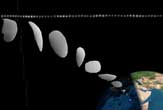Asteroid Threat Early Warning System Proposed

HONOLULU, Hawaii — Scientists are taking a hard look at a proposal to keep a high-tech, yet low-cost, eye on the heavens for asteroids or comets that may Earth in their crosshairs.
The proposal is dubbed ATLAS — short for the Asteroid Terrestrial-impact Last Alert System — and calls for two telescopes to serve as an early warning system against incoming asteroids. Scientists hope such a system could provide many hours or days notice of an impending Earth impact.
Leading the ATLAS effort here are space scientists John Tonry and Robert Jedicke of the Institute for Astronomy at the University of Hawaii.
As sketched out, the proposed ATLAS project would include two observatories separated by about 60 miles (100 km) that can simultaneously scan the entire night sky visible from their locations twice a night. Each observatory would be composed of four commercially available telescopes, with two at each site observing the same region of the sky. [5 reasons to care about asteroids.]
The difference in apparent position of an object when viewed along two different lines of sight — called parallax — offered by the observing stations would provide a way of separating nearby and distant moving objects. As designed, the system would have a search range of about 10 times the distance between the Earth and the moon. The average distance to the moon is about
Expanding the system to four geographically well-separated sites (which calls for eight observatories, two per site) could allow astronomers to watch on the entire sky for asteroids and bolides — meteors that hit Earth's atmosphere and explode. The telescopes would be arranged in pairs at two sites in the northern hemisphere and two in the southern hemisphere.
Trio of technologies
Sign up for the Live Science daily newsletter now
Get the world’s most fascinating discoveries delivered straight to your inbox.
"It’s a time for this technology right now," said Robert Jedicke, a co-investigator for ATLAS.
Jedicke pointed out that what makes ATLAS possible is the melding of a trio of technologies:
- Digital camera and large, high-quality charge-coupled device (CCD) arrays can be fashioned at affordable prices.
- Small telescopes with exquisite optics are available that cover a large field of view.
- High-speed computers allow the processing of data on a nightly basis.
"All those three things had to come together. You couldn’t do this project five years ago," Jedicke told SPACE.com. "And we want to be the first people to do it."
By starting off small with just two ATLAS observatories, a good part of the job can be accomplished, Jedicke said.
"You need about one million dollars in order to get one of these units. They can be installed at small colleges, in various countries around the world," he added. "Anybody can buy into it."
Tonry said that ATLAS is officially a project, albeit on paper, since it has been proposed to NASA for funding.
Considerable effort has already been performed to calculate the effectiveness of ATLAS against asteroids of various sizes, as well as work on the camera design and alternative telescope schemes, he added.
Poster child: asteroid 2008 TC3
When it comes to disaster early warning systems, Jedicke stressed that there is a difference between asteroid impacts and earthquake, hurricane or tornado predictions.
"With a tornado you can give a little bit of warning. A day or two of warning can be done for a hurricane. An earthquake, you’ve got no warning at all," Jedicke explained.
"But with asteroid impacts, we can do something about them, providing people weeks to years to hundreds of years of notice," he added. "It’s a distinctly different kind of natural threat than all the other natural threats out there."
ATLAS would be ideal to spot objects en route to Earth like Asteroid 2008 TC3 that crashed into the Earth’s atmosphere in 2008.
"That object is like the poster child for what we want to do," Jedicke said. "Of course, there’s the practical aspect of realizing that we can actually find these objects before the hit, predict they are going to hit, and then go find chunks."
"Once we get ATLAS running, we’ll be able to find an object like TC3 at least once a year. We can predict exactly when it’s going to hit," Jedicke added. "That’s also scientifically very important."
Crash site
Asteroid 2008 TC3 was a small object that impacted in northern Sudan on Oct. 7, 2008. The asteroid was shaped like a loaf of walnut-raisin bread, according to astronomer Peter Scheirich and colleagues at Ondrejov Observatory and Charles University in the Czech Republic.
More importantly, it was the first space rock to have been spotted in space by ground observers before the asteroid hit Earth.
The asteroid was discovered by the automated Catalina Sky Survey telescope at Mount Lemmon, Arizona on Oct. 6, 2008. Early calculations showed an impact 19 hours after discovery with a forecast of the impact spot pinpointed in the Nubian Desert of northern Sudan.
A follow-up trek to the crash site was orchestrated by Peter Jenniskens, a research scientist at the SETI Institute in Mountain View, Calif. — a search aided by Sudan astronomer Muawia Shaddad and 45 students of the University of Khartoum. By carefully sweeping the desert, hundreds of asteroid fragments were recovered.
The result is a gigantic jigsaw puzzle from which researchers are creating a picture of the asteroid and its origins, Jenniskens emphasized during Meteoroids 2010, a meeting of international experts held earlier this year in Breckenridge, Colorado. That gathering also received a briefing on ATLAS by Jedicke.
Systematic last-minute warning
Casting an interested eye on the ATLAS proposal is former Apollo astronaut, Russell (Rusty) Schweickart, Chairman of the Board of the B612 Foundation, a non-profit private foundation that champions the development and testing of a spaceflight concept to protect the Earth from future asteroid impacts.
Schweickart is founder and past president of the Association of Space Explorers, the international professional society of astronauts and cosmonauts. Of late, he’s been busily working on implementation issues regarding a near-Earth object Information, Analysis, and Warning Network for consideration by the United Nations.
"ATLAS is the first specific telescopic system designed to provide a last-minute warning for asteroids in final approach to an Earth impact," Schweickart told SPACE.com.
As the first NEO discovered immediately pre-impact — for which an impact time and location were forecast, and from which fragments were collected immediately afterward for analysis — that event highlighted the potential for systematic last-minute warning, Schweickart said.
"It appears that for roughly 60 percent of impactors roughly 100 to 130 feet (30 to 40 meters) in size, days of warning can be provided. For objects to some 450 feet (140 meters) and above size, weeks of warning are possible," he added.
An attractive feature of the proposed ATLAS system, Schweickart said, is the low cost, due primarily to the use of small off-the-shelf commercially available telescopes, combined with available software adapted from the Panoramic Survey Telescope and Rapid Response System (Pan- STARRS) - an innovative design for a wide-field imaging facility also being developed at the University of Hawaii’s Institute for Astronomy.
"If the cost can in fact be held down to the vicinity of $1 million dollars, once in production, then serious amateur astronomy groups, university astronomy departments, and others distributed around the world could become an integral part of a warning, as well as discovery, network," Schweickart said. "Very exciting."
- Gallery - Asteroids Up Close, Astronauts on Asteroids
- Will an Asteroid Hit Earth? Are We All Doomed?
- NASA Panel Calls for Asteroid Defense Office
Leonard David has been reporting on the space industry for more than five decades. He is past editor-in-chief of the National Space Society's Ad Astra and Space World magazines and has written for SPACE.com since 1999.

Leonard David is an award-winning space journalist who has been reporting on space activities for more than 50 years.









